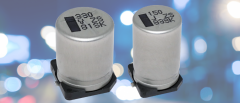Hybrid Caps - Let's Talk About the Future

Future Requirements and Challenges
Driven by automotive manufacturers, suppliers are more and more focusing on hybrid capacitors. However, hybrid caps are not only perfectly fitting for this market, we also see demand in the industrial market, white goods/household appliances and power tools. Several applications apart from the automotive market can also benefit from the properties of those capacitors.
We will give you a preview of what you can expect in the future.
Focus on Miniaturization
Hybrid capacitors are available in dimensions with diameter up to 10mm. From the current point of view, this will stay the same in future. Ideally, ESR efficiency of hybrid capacitors is better than that of e-caps, even at bigger sizes. But because of the fact that the resistance of aluminum foil has a higher ratio at bigger diameters, it seems that they lose their strength over 10mm diameter. Therefore, our manufacturers are strongly focusing on miniaturization. New materials and substances are in research to achieve higher capacitances and ripple current capability in existing case sizes. Additionally, our partners are developing, or have already available, different heights of up to 20mm with a diameter of 10mm. Moreover, when we talk about miniaturization, small size starts at 5x6mm. This will be new at higher temperature series.
Maximum Rated Temperature of 170°C
When it comes to the maximum rated temperature, this is 150°C now. The bottleneck is the rubber, which seals the aluminum can. With higher temperatures the rubber will get porous much quicker, which leads to an easy vaporization of the electrolyte. The future direction is 170°C in a first step, but in a few years only, as new reliable materials are needed. Much later 200°C might follow. In case your mission profile requires higher temperatures than 150°C for a short time, please contact us for a lifetime calculation and confirmation of the manufacturer.
Voltage Range up to 250V
The voltage range is up to 125V currently. Limiting factor is the polymer itself. It seems that new, improved polymer material will be available at our suppliers in a few years. Then hybrid capacitors can withstand a rated voltage of 250V. Next target after that are 400V in some years.
Key point of all those development directions is keeping the advantage against electrolytic capacitors in terms of ripple current capability comparing the same case sizes. Not only material research and testing is essential to reach new targets, but also market demand. Our suppliers and we as well are curious about your opinion and requirements on hybrid capacitors. Please tell us what you are missing in the current portfolio and how you think about the future direction.
Your Contact Person
For more information, please contact Yasunobu Ikuno or Roland Trimmel.


